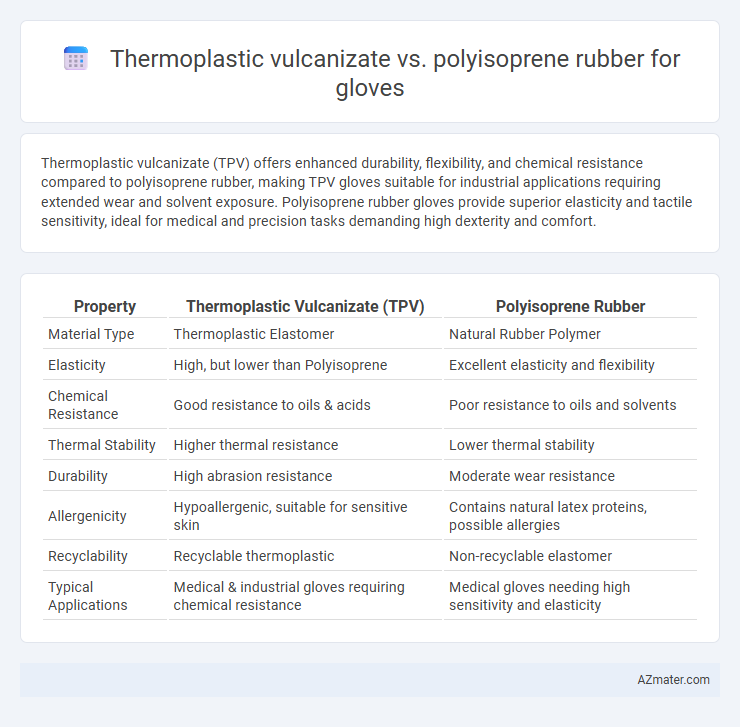Thermoplastic vulcanizate (TPV) offers enhanced durability, flexibility, and chemical resistance compared to polyisoprene rubber, making TPV gloves suitable for industrial applications requiring extended wear and solvent exposure. Polyisoprene rubber gloves provide superior elasticity and tactile sensitivity, ideal for medical and precision tasks demanding high dexterity and comfort.
Table of Comparison
| Property | Thermoplastic Vulcanizate (TPV) | Polyisoprene Rubber |
|---|---|---|
| Material Type | Thermoplastic Elastomer | Natural Rubber Polymer |
| Elasticity | High, but lower than Polyisoprene | Excellent elasticity and flexibility |
| Chemical Resistance | Good resistance to oils & acids | Poor resistance to oils and solvents |
| Thermal Stability | Higher thermal resistance | Lower thermal stability |
| Durability | High abrasion resistance | Moderate wear resistance |
| Allergenicity | Hypoallergenic, suitable for sensitive skin | Contains natural latex proteins, possible allergies |
| Recyclability | Recyclable thermoplastic | Non-recyclable elastomer |
| Typical Applications | Medical & industrial gloves requiring chemical resistance | Medical gloves needing high sensitivity and elasticity |
Introduction to Glove Materials
Thermoplastic vulcanizate (TPV) combines the elastic properties of rubber with the processability of thermoplastics, making it ideal for durable, flexible gloves used in medical and industrial settings. Polyisoprene rubber offers excellent elasticity, comfort, and tactile sensitivity, closely mimicking natural rubber, which makes it preferred for medical examination gloves requiring high dexterity. Both materials serve critical roles in glove manufacturing, with TPV favored for chemical resistance and reusability, while polyisoprene excels in elasticity and allergen-free properties.
Overview of Thermoplastic Vulcanizate (TPV)
Thermoplastic vulcanizate (TPV) is a dynamic elastomer combining rubber-like flexibility with thermoplastic processability, ideal for durable gloves requiring elasticity and chemical resistance. TPV exhibits excellent heat resistance, tensile strength, and stress crack performance, outperforming many traditional elastomers like polyisoprene in durability and reusability. Its ability to be molded repeatedly without significant degradation makes TPV gloves cost-effective and suitable for applications demanding consistent protection and comfort.
Understanding Polyisoprene Rubber
Polyisoprene rubber, a synthetic elastomer closely resembling natural rubber, offers superior elasticity, resilience, and tactile sensitivity, making it an excellent material choice for gloves requiring high dexterity and comfort. Unlike thermoplastic vulcanizates (TPVs), which combine rubber and plastic properties to provide enhanced chemical resistance and durability, polyisoprene excels in biocompatibility and hypoallergenic attributes, crucial for medical and surgical gloves. Its low protein content and soft texture reduce allergic reactions while maintaining excellent tear resistance and flexible fit, essential for precise hand movements in clinical environments.
Material Properties Comparison: TPV vs Polyisoprene
Thermoplastic vulcanizate (TPV) offers superior chemical resistance and enhanced flexibility compared to polyisoprene rubber, making it ideal for gloves requiring durability in harsh environments. Polyisoprene rubber provides excellent elasticity and natural tactile sensitivity, closely mimicking the properties of natural latex, which benefits precision tasks. TPV demonstrates higher thermal stability and long-term aging resistance, whereas polyisoprene excels in biodegradability but may degrade faster under UV exposure and ozone.
Chemical Resistance in Glove Applications
Thermoplastic vulcanizate (TPV) exhibits superior chemical resistance compared to polyisoprene rubber in glove applications, particularly against oils, solvents, and acids, ensuring enhanced durability and protection. Polyisoprene rubber offers limited resistance to hydrocarbons and certain solvents, making it less suitable for industrial environments involving aggressive chemicals. The molecular structure of TPV provides a robust barrier against chemical permeation, increasing glove lifespan in demanding chemical handling tasks.
Mechanical Strength and Durability
Thermoplastic vulcanizate (TPV) gloves exhibit superior mechanical strength and durability compared to polyisoprene rubber gloves due to their unique blend of thermoplastic and elastomeric properties, which provide enhanced resistance to wear, tear, and deformation under stress. TPV maintains excellent tensile strength and elongation at break, ensuring prolonged glove lifespan even in high-stress environments. Polyisoprene rubber, while offering good elasticity and comfort, typically shows lower mechanical robustness and faster degradation when exposed to repeated mechanical strain.
Comfort and Fit for End-Users
Thermoplastic vulcanizate (TPV) gloves offer enhanced elasticity and shape retention, providing a snug, glove-like fit that adapts to hand movements for superior comfort during extended wear. Polyisoprene rubber gloves mimic natural latex with excellent elasticity and softness, delivering a precise fit and tactile sensitivity favored by medical professionals. While TPV gloves excel in durability and recovery from deformation, polyisoprene gloves prioritize a natural feel and breathability, crucial for minimizing hand fatigue in prolonged use.
Cost Efficiency and Manufacturing Considerations
Thermoplastic vulcanizate (TPV) offers superior cost efficiency compared to polyisoprene rubber due to its recyclability, faster processing times, and lower raw material costs, making it ideal for high-volume glove production. Polyisoprene rubber, while providing excellent elasticity and tactile sensitivity, involves longer vulcanization cycles and higher material expenses, increasing overall manufacturing costs. The ease of injection molding TPV reduces labor and energy consumption, allowing manufacturers to optimize throughput and minimize waste in glove production lines.
Environmental Impact and Sustainability
Thermoplastic vulcanizate (TPV) gloves offer improved environmental sustainability due to their recyclability and lower energy consumption during production compared to polyisoprene rubber gloves. Polyisoprene rubber, being a natural latex, is biodegradable but involves more intensive agricultural resource use and potential allergen concerns. TPV's ability to be reprocessed and reduced landfill waste enhances its appeal as an eco-friendly alternative in glove manufacturing.
Choosing the Best Material for Glove Production
Thermoplastic vulcanizate (TPV) offers superior flexibility, chemical resistance, and recyclability compared to polyisoprene rubber, making it ideal for durable and environmentally friendly glove production. Polyisoprene rubber excels in elasticity and tactile sensitivity, preferred for medical and precision applications requiring high comfort and dexterity. Selecting the best material depends on balancing performance requirements such as durability, sensitivity, and cost-effectiveness relative to the intended glove use.

Infographic: Thermoplastic vulcanizate vs Polyisoprene rubber for Glove
 azmater.com
azmater.com